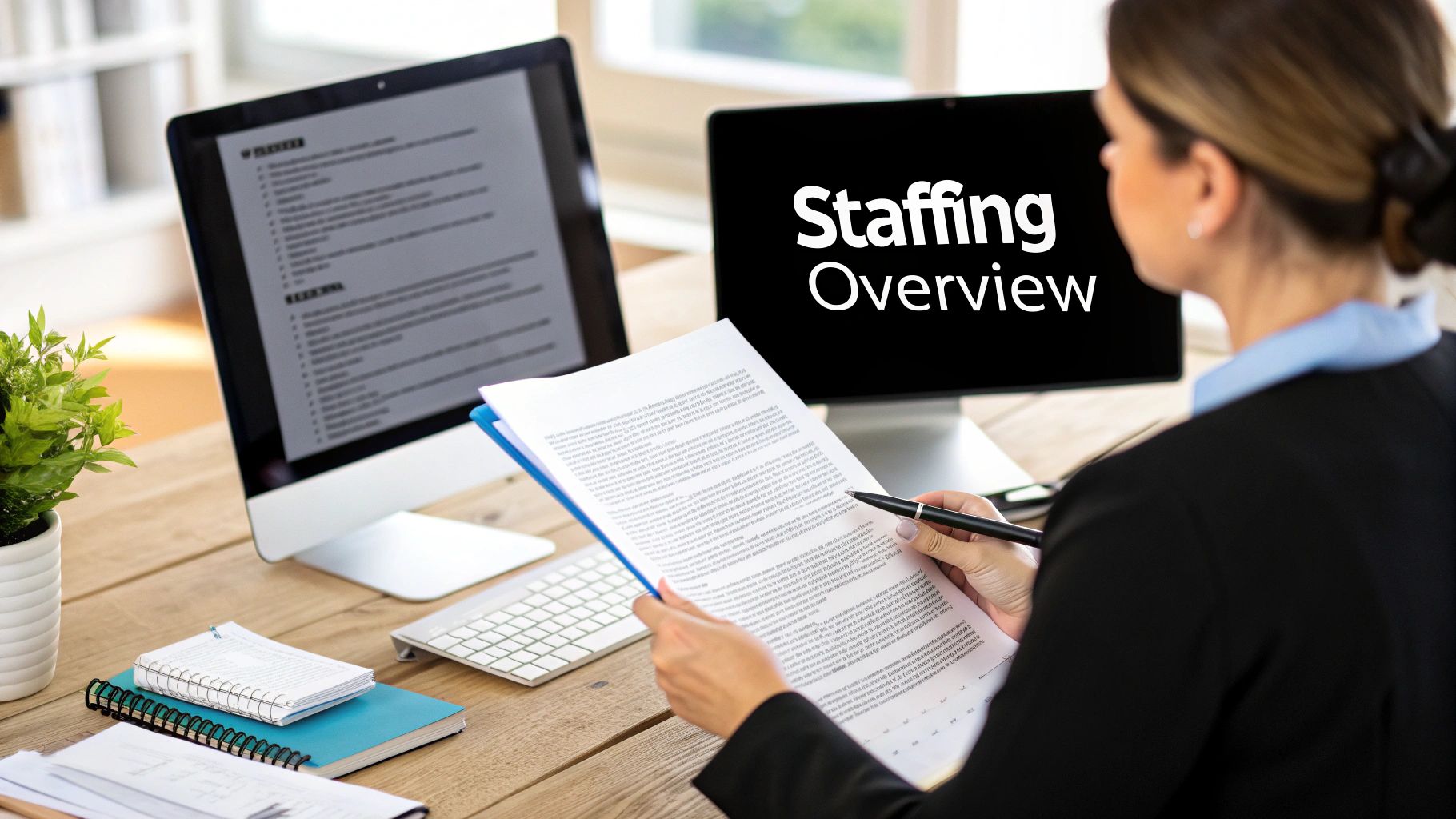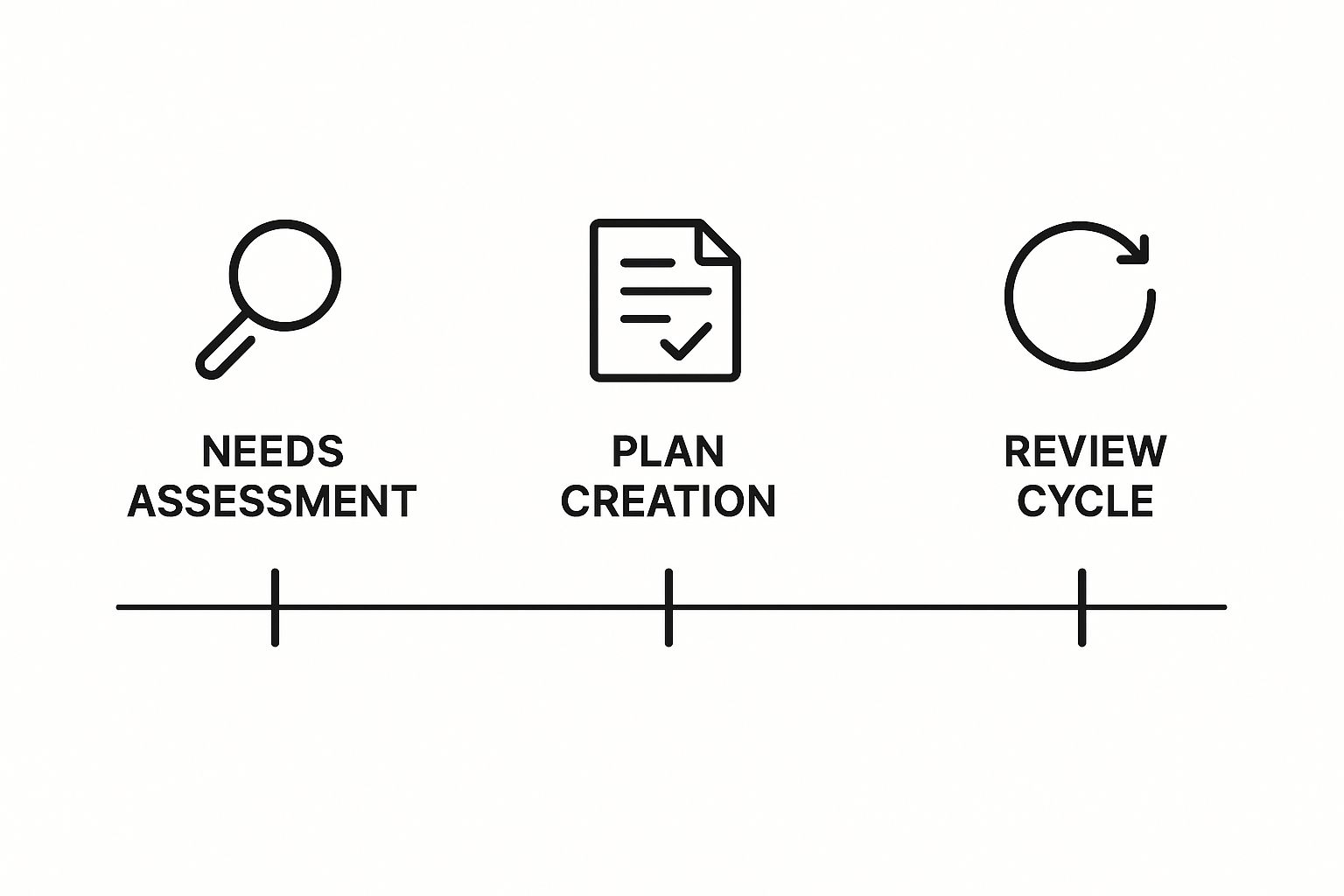Decoding Sample Staffing Plans: Why They Matter Now

A sample staffing plan is more than just an HR document. It's a strategic roadmap that guides your organization toward success. It’s a dynamic tool, allowing businesses to adapt to changing market conditions and achieve their objectives. This proactive approach to workforce management is increasingly vital in today's competitive business world.
Why Sample Staffing Plans Are Crucial For Success
Effective staffing plans help organizations anticipate future needs. For example, a rapidly growing company might project how many new employees they'll need in the next year and in which roles.
This foresight enables proactive talent recruitment and avoids costly delays from unexpected growth. A well-defined plan also helps manage talent pipelines, ensuring a consistent flow of qualified candidates.
This means businesses can quickly fill open positions and maintain operational efficiency. Ultimately, a robust staffing plan provides a competitive advantage by having the right people with the right skills at the right time. The global staffing market shows this growing need.
It's projected to reach $650 billion in 2025, a 5% growth driven largely by temporary staffing solutions. This growth is impacted by economic uncertainties and evolving client behaviors. Find more detailed statistics here
Tailoring Your Approach: Startup Vs. Enterprise
Staffing plans differ significantly across company sizes and industries. A startup might prioritize flexibility and adaptability, focusing on hiring individuals with diverse skill sets. These individuals often wear multiple hats.
A large enterprise might require a more structured and detailed plan. This plan outlines specific roles, responsibilities, and reporting structures within each department. Whether for a small team or a large division, a well-defined staffing plan allows for strategic growth and adaptation.
These plans act as living documents, continually evolving to meet the organization's changing needs.
Core Components of An Effective Staffing Plan
A successful sample staffing plan has several key components. These elements work together to create a holistic view of workforce needs. The following table outlines the essential elements:
Core Components of an Effective Staffing Plan
This table outlines the essential elements that should be included in any comprehensive staffing plan
| Component | Purpose | Implementation Considerations |
|---|---|---|
| Workforce Analysis | Assess current workforce skills, strengths, and weaknesses. | Use data-driven assessments, employee surveys, and performance reviews to gain a clear understanding of existing talent. |
| Future Needs Forecasting | Project future workforce requirements based on business goals and market trends. | Consider factors such as projected growth, industry trends, and technological advancements. |
| Gap Analysis | Identify discrepancies between current workforce capabilities and future needs. | Analyze skill gaps, potential shortages, and areas for improvement. |
| Recruitment Strategy | Outline methods for attracting and hiring qualified candidates. | Develop a targeted recruitment plan that includes specific sourcing strategies, interview processes, and onboarding procedures. |
| Training and Development Plan | Detail plans for upskilling current employees and developing future leaders. | Implement training programs, mentorship initiatives, and career development opportunities to enhance workforce capabilities. |
By incorporating these components, organizations create a comprehensive staffing plan addressing current and future workforce needs. This ensures businesses are prepared to handle challenges and capitalize on opportunities in the dynamic marketplace.
Essential Elements of Your Sample Staffing Plan Template
A well-crafted sample staffing plan isn't simply about filling open roles. It's a strategic roadmap that aligns your workforce with your business objectives, ensuring you have the right people with the right skills at the right time. This involves carefully evaluating your current team, projecting future needs, and creating a clear plan to bridge any gaps.
Understanding Current and Future Needs
The first step is a comprehensive workforce assessment. This involves analyzing the skills, strengths, and weaknesses of your existing employees. You also need to project your future talent needs based on factors like business goals, anticipated market trends, and potential industry shifts.
For instance, if your company is planning to expand into a new market, your staffing plan should account for the specific skills and expertise required for that venture. This proactive approach to talent planning prevents last-minute scrambles for qualified candidates when new opportunities arise.
Bridging the Gap: Recruitment and Development
After identifying the gap between your current workforce and future requirements, the next step is developing a solid recruitment strategy. This plan outlines how you'll attract, hire, and onboard qualified candidates. It's about more than just posting job openings; it requires a targeted approach that considers the unique skills and experience needed for each role. For more information, check out this resource on crafting effective job listings: How to master job listings
Recruitment is only part of the equation. A comprehensive staffing plan also includes training and development initiatives. These programs focus on upskilling current employees and preparing them for future roles within the company. This proactive approach not only addresses potential skill gaps but also boosts employee engagement and retention. You're investing in your existing team while simultaneously planning for the future. The U.S. staffing industry, valued at approximately $198.7 billion and comprising nearly 26,000 agencies, highlights the importance of strategic staffing. Explore this topic further
Balancing Flexibility and Strategic Direction

A sample staffing plan offers a helpful framework, but maintaining flexibility is essential. Shifting market conditions, evolving business priorities, and even internal restructuring can require adjustments to your plan. This adaptability is crucial for navigating unforeseen challenges and capitalizing on new opportunities.
Your staffing plan should be a dynamic tool that evolves alongside your organization. Building in contingencies and alternative scenarios helps you respond effectively to unexpected circumstances. This isn't about abandoning your strategic direction; it's about adapting your approach while still pursuing your overarching goals. A well-structured sample staffing plan template incorporates this flexibility while ensuring your workforce strategy remains aligned with your business vision, allowing your organization to thrive in a dynamic environment.
Crafting Your Sample Staffing Plan: A Practical Roadmap

Turning a template into a working sample staffing plan takes a practical, step-by-step process. This roadmap emphasizes actionable steps and real-world examples to help you build a strong team. We'll dive into workforce analysis, setting realistic recruitment timelines, and building solid budget frameworks.
Workforce Analysis: Understanding Your Team
Start by carefully evaluating your current team. Identify their existing skills, pinpoint strengths, and acknowledge any areas for improvement. Go beyond simply listing job titles. Instead, understand your team's collective skill set.
For a more detailed understanding, use tools like skills assessments and performance reviews. These provide a granular view of your team's potential. This deeper analysis reveals true skill gaps, which helps with resource allocation and strategic planning. It focuses your recruitment and training where they'll make the biggest difference. This leads us to setting realistic recruitment timelines. You might also find this article helpful: How to master creative staffing
Recruitment Timelines: Setting Realistic Expectations
Realistic recruitment timelines are key to successful staffing. Consider the current job market. For competitive roles, expect longer lead times.
Factor in internal hiring processes too. This includes interviews and onboarding. Including these details helps create a timeline aligned with your business goals. It manages expectations and prevents delays in filling crucial roles, leading to smooth transitions for new hires. Now, let's discuss the budget.
Budget Frameworks: Planning for Success
A solid budget is essential for any staffing plan. Accurately estimate costs for recruitment, training, and onboarding. Consider both direct costs (salaries, benefits) and indirect costs (agency fees, training materials).
Your budget should match your overall business strategy. Prioritize key roles and invest resources where they'll have the greatest impact. A well-structured budget helps track spending and allows you to make smart decisions throughout the process. This financial planning ensures your staffing plan works and contributes to your organization's long-term success. Factors like technological advancements and economic conditions heavily influence staffing trends. A key trend is the growing use of AI in recruitment and a focus on skills-based hiring. Learn more about staffing trends here
Staffing Plan Development Timeline
The following timeline illustrates the phases and activities involved in creating a comprehensive staffing plan.
Phase 1: Assessment (2-4 weeks)
- Analyze current workforce skills and identify existing gaps.
- Forecast future staffing needs based on business objectives.
Phase 2: Strategy (4-6 weeks)
- Develop a tailored recruitment strategy targeting specific skill sets.
- Outline training and development programs to address identified gaps.
Phase 3: Implementation (8-12 weeks)
- Begin active recruitment efforts, including sourcing and interviewing candidates.
- Implement training programs for current employees.
Phase 4: Evaluation (Ongoing)
- Monitor key metrics like time-to-fill and employee retention.
- Adjust the staffing plan as needed based on performance data and market trends.
This timeline provides a structured approach to building a complete sample staffing plan. The assessment phase establishes a baseline by analyzing current capabilities and predicting future needs. The strategy phase focuses on targeted recruitment and training. Implementation puts those plans into motion, while the evaluation phase allows for continuous improvement. This cyclical process ensures your plan stays dynamic and adapts to the changing demands of your organization.
Industry-Specific Sample Staffing Plans That Work

Creating a sample staffing plan requires more than a generic template. Each industry presents unique challenges and demands. Just as a skyscraper and a cottage need different blueprints, a tech startup and a hospital need distinct staffing strategies. The right plan ensures you have the right people in the right roles at the right time.
Healthcare: Balancing Expertise and Compliance
Healthcare staffing involves a delicate balancing act. Organizations must ensure they have enough qualified professionals to deliver quality patient care. This includes not only sufficient numbers of nurses and doctors but also the right mix of specialists, like critical care or emergency medicine certified nurses.
Furthermore, healthcare providers must adhere to strict regulatory requirements. HIPAA and other regulations demand rigorous record-keeping and specific hiring protocols. Finding the right balance between specialized skills and regulatory compliance is key to effective healthcare staffing. You might find helpful tips at How to master creative job listings.
Tech: Fueling Innovation Through Talent
The tech industry thrives on innovation, requiring a dynamic staffing approach. Attracting and retaining skilled professionals in areas like software development, data science, and artificial intelligence is critical.
Tech companies often offer competitive compensation packages and cultivate a culture of continuous learning. They also invest in strategic talent pipelines, proactively identifying and nurturing promising candidates, much like a baseball team develops its farm system. This forward-thinking approach helps tech companies stay ahead in a constantly evolving landscape.
Manufacturing: Optimizing Efficiency and Skills
Manufacturing staffing focuses on optimizing efficiency and acquiring specialized skills. A well-staffed production line requires the correct number of workers with the appropriate technical expertise to operate machinery and maintain smooth operations.
However, the rise of automation is transforming the manufacturing landscape. While some traditional roles may be phased out, new opportunities are emerging in areas like robotics and automation. Successful manufacturers adapt their staffing plans to reflect these shifting skill demands.
Industry-Specific Staffing Considerations
To further illustrate the unique needs of each industry, the following table summarizes key staffing factors. It provides a comparison across different sectors, highlighting unique challenges, skill sets, and recommended recruitment approaches.
| Industry | Typical Staffing Challenges | Required Skill Sets | Recommended Recruitment Approaches |
|---|---|---|---|
| Healthcare | Balancing clinical expertise with regulatory compliance | Specialized medical certifications, patient care skills | Targeted recruitment campaigns, partnerships with nursing schools |
| Tech | Attracting and retaining highly skilled professionals | Software development, data science, AI | Competitive compensation, continuous learning opportunities |
| Manufacturing | Optimizing efficiency and adapting to automation | Technical skills, robotics, automation expertise | Upskilling programs, apprenticeships, technical recruitment agencies |
As this table shows, a one-size-fits-all approach to staffing simply won't work. Each industry presents its own set of requirements and obstacles. Developing effective sample staffing plans requires a deep understanding of these nuances. By tailoring their strategies, businesses can ensure they have the right talent to achieve their goals.
Overcoming Real-World Staffing Plan Obstacles
Even the most comprehensive sample staffing plan can hit unexpected roadblocks. This section explores common challenges, from budget limitations to talent shortages, and offers practical solutions. We'll discuss how organizations successfully manage these obstacles and keep their staffing strategies on track.
Navigating Budgetary Constraints
Budget constraints are a frequent challenge in staffing. These limitations often necessitate difficult decisions about role prioritization. A practical solution involves a thorough return on investment analysis for each position.
Focus on roles directly impacting revenue generation or essential business operations. Consider it like prioritizing home repairs: a leaky roof takes precedence over repainting. Similarly, prioritize essential roles over less critical ones to maximize resource impact.
Addressing Talent Shortages
Talent shortages in critical areas can significantly affect a staffing plan. When finding the ideal candidate proves difficult, organizations need creative solutions. One effective approach is upskilling existing employees to fill these skill gaps. This not only addresses immediate needs but also invests in employee development.
Another tactic is broadening your search criteria. Look for candidates with transferable skills who can be trained for specific roles. Expanding your talent pool allows you to discover individuals with diverse backgrounds and perspectives.
Maintaining Flexibility in a Volatile Market
Market volatility can disrupt even the most meticulous plans. Unexpected downturns or sudden demand surges require adjustments. A flexible staffing plan incorporates contingencies for various scenarios, allowing your organization to respond effectively to market shifts.
Flexibility doesn't mean abandoning long-term strategy. It's about adapting to changing conditions like a ship navigating stormy waters. Your plan should navigate unexpected challenges while maintaining its overall course. You might be interested in: How to master staffing plans
Managing Stakeholder Expectations
Stakeholders, like executives and department heads, have expectations regarding staffing. Managing these expectations necessitates clear communication and transparency. Regular updates on your plan's progress and any encountered challenges are key.
Open communication fosters trust and ensures everyone is aligned. This transparency promotes collaborative problem-solving and a shared understanding of the organization's staffing needs.
Adapting to Unexpected Changes
Unexpected events, like a key employee's sudden resignation, can disrupt a staffing plan. A process for quickly adapting to such changes is essential. This includes maintaining a pool of potential candidates for critical roles.
Cross-training employees provides backup support for unexpected vacancies. This preparedness minimizes disruption and ensures business continuity, even with unexpected departures.
By addressing these real-world obstacles, organizations ensure their sample staffing plans remain effective tools for achieving business objectives. These aren't just theoretical solutions; they're practical strategies used by successful companies. These strategies build resilience, enabling businesses to thrive even in times of uncertainty.
Measuring What Matters: Is Your Staffing Plan Working?
A sample staffing plan isn't something you create and then forget. Its real value comes from its ability to adapt as your organization changes and grows. But how can you tell if your plan is truly effective? This section explores the key metrics that show whether your staffing efforts are getting results, going beyond superficial numbers to focus on indicators that really matter.
Key Performance Indicators (KPIs) for Staffing Effectiveness
Measuring the success of your staffing plan means focusing on the right Key Performance Indicators (KPIs). These metrics offer valuable insights into how well your strategies are working and where you can improve.
-
Time-to-Productivity: This measures how long it takes for new hires to become fully contributing members of the team. A shorter time-to-productivity suggests a more efficient onboarding process and better integration of new talent.
-
Cost-per-Hire: This metric calculates the total cost of hiring a new employee, including recruitment, advertising, and onboarding expenses. Reducing your cost-per-hire improves your bottom line and makes the most of your recruitment budget.
-
Employee Turnover Rate: This metric tracks how often employees leave your organization. A high turnover rate may point to potential problems with employee satisfaction, the work environment, or alignment with company culture, impacting your overall costs and team stability.
Tracking these quantitative indicators offers valuable data-driven insights into how effective your staffing strategies are. But numbers don’t tell the whole story. Qualitative measures are important too.
Beyond the Numbers: Qualitative Measurement
Numbers provide a crucial snapshot of performance, but qualitative assessments offer deeper insights into your staffing plan’s real impact.
-
Skills Alignment: Does your team have the skills needed to meet your business objectives? Evaluating skills alignment shows if your recruitment strategy is attracting the right talent and if your training programs are effectively developing current employees.
-
Team Integration Success: How well do new hires blend into your existing teams? Successful integration creates a positive work environment, boosts collaboration, and contributes to better employee retention.
These qualitative factors give context to the quantitative KPIs, painting a more complete picture of your staffing plan’s success. For instance, a low cost-per-hire may seem good, but if new hires aren’t integrating well, it could hurt productivity and morale.
Establishing Benchmarks and Tracking Systems
To effectively measure your staffing plan’s performance, you need to set meaningful benchmarks. These benchmarks should be tailored to your organization and industry, reflecting your specific situation and goals. For example, a tech startup’s time-to-productivity benchmark might be very different from that of a healthcare organization.
Setting up sustainable tracking systems is also essential. This means consistently collecting data on your chosen KPIs and qualitative measures. Regularly reviewing this data helps spot trends, pinpoint areas for improvement, and allows for informed decisions. Learn more in our article about how to master staffing plan measurement.
Translating Data into Strategic Adjustments
Collecting data is only useful if it leads to actionable insights. Regularly analyze your staffing plan’s performance and use the data to make strategic changes. If your time-to-productivity is too long, your onboarding process might need improvement. A high turnover rate may signal a need to address company culture or employee engagement.
By constantly evaluating your staffing plan and making data-driven adjustments, you can ensure your workforce strategy aligns with your business objectives. This ongoing improvement process optimizes your staffing efforts and contributes to long-term success.
Ready to transform your creative staffing strategy? Creativize connects you with top local talent to bring your vision to life. Visit us today to discover how we can help you build a dynamic and successful team.

